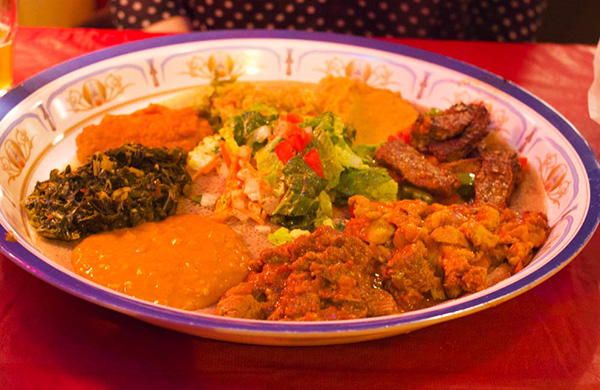
The vast majority of Americans take the easy way out when ordering Ethiopian food: ordering the combo plate, a pre-selected plate of five or more dishes--mostly dollops of lentil and difficult-to-identify stews. Seattle’s huge population of Ethiopian immigrants means some of the best Ethiopian food in the country. So it’s time to take the ordering up a notch. There is so much more to the cuisine than randomly picking through various puddles of flavor—of course it’s still delicious, but why not try ordering a few dishes to find out what you really love?
Before navigating individual dishes, the first thing to learn are the three basic building blocks of Ethiopian food:
Injera: The spongy grayish-brown bread served both under and on the side of nearly every tray of Ethiopian food. It looks about as appetizing as a yoga mat, and on its own, it doesn’t taste much better. When it sops up the spices and nitter kibe (see below) from dishes, the sour undertones even out and the texture softens. Don’t try it alone and give up! It’s traditionally made only with the grain teff, but most local restaurants adjust for the altitude (Seattle, at sea level, is much lower than most of Ethiopia) by supplementing with wheat flour. Often requests for all-teff (thus gluten-free) injera can be filled with advanced notice.
Nitter Kibe: A clarified butter (like Indian ghee) infused with spices. The rich aromatic fat is the base for many dishes. At restaurants that serve vegan versions of their menu items, there is a perceptible lack of the deep flavor that comes from using nitter kibe as the base for cooking.
Berebere: A red-pepper-based spice mix that is used in many dishes, as well as often being offered on the table to add a little extra heat to a dish.
Once familiar with the building blocks, it’s time to learn what the dishes are:
Wat: Wat is stew, generally slightly spicy (flavored with berebere). For a milder stew, look for the turmeric-based alicha versions. Doro wat is the most common, a chicken stew served with hard-boiled egg. Other versions include shiro (chickpea flour) and misir (red lentil), the latter of which is often found on those ubiquitous combo plates.
Tibs: A sauté of meat and vegetables, often including onion and peppers. Often seen with either lamb or beef.
Fitfit or firfir: This name refers to shredded injera that is sautéed in nitter kibe. Mostly, this is woven into a stew or dish, and referred to in combination with that dish name. A favorite is quanta fitfit, a dish of the softened injera studded with bits of Ethiopian-style dried beef.
Kitfo: Beef, served raw but lightly warmed in nitter kibe, and spiced with berebere. Often served with gomen (greens) and a light, fresh cheese. The warm meat and cool cheese contrast with the spice in this special-occasion dish. Also available lightly cooked most places.
There’s nothing to do now but muster up some courage and step outside the combination plate box. Those in need of a little courage can order a bottle of Harrar (or other Ethiopian beer) or a glass of tejj (Ethiopian honey wine).
Seattle is a sea of great Ethiopian restaurants, but the best two for rookies are Jebena Cafe in Pinehurst (a cute cafe with friendly service and great coffee) and Meskel in the Central District, which has a beautiful old Craftsman setting upstairs and a rowdy soccer bar downstairs.








